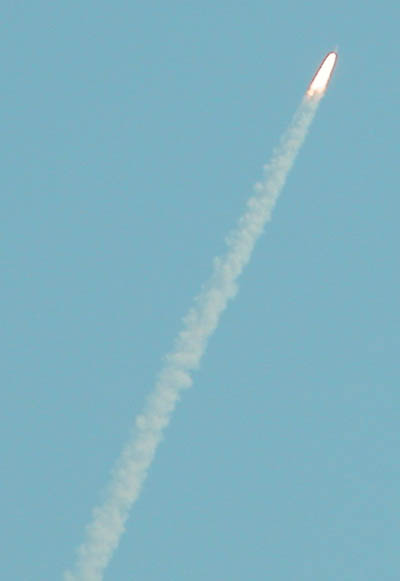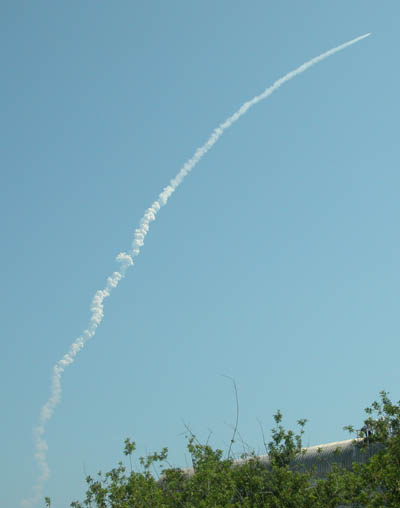This is the website of Abulsme Noibatno Itramne (also known as Sam Minter).
Posts here are rare these days. For current stuff, follow me on Mastodon
|
Very Cool Article
Our world may be a giant hologram
(Marcus Chown, New Scientist, 15 Jan 2009)
For the past seven years, this German set-up has been looking for gravitational waves – ripples in space-time thrown off by super-dense astronomical objects such as neutron stars and black holes. GEO600 has not detected any gravitational waves so far, but it might inadvertently have made the most important discovery in physics for half a century.
For many months, the GEO600 team-members had been scratching their heads over inexplicable noise that is plaguing their giant detector. Then, out of the blue, a researcher approached them with an explanation. In fact, he had even predicted the noise before he knew they were detecting it. According to Craig Hogan, a physicist at the Fermilab particle physics lab in Batavia, Illinois, GEO600 has stumbled upon the fundamental limit of space-time – the point where space-time stops behaving like the smooth continuum Einstein described and instead dissolves into “grains”, just as a newspaper photograph dissolves into dots as you zoom in. “It looks like GEO600 is being buffeted by the microscopic quantum convulsions of space-time,” says Hogan.
If this doesn’t blow your socks off, then Hogan, who has just been appointed director of Fermilab’s Center for Particle Astrophysics, has an even bigger shock in store: “If the GEO600 result is what I suspect it is, then we are all living in a giant cosmic hologram.”
(via Gizmodo)
And yes, the podcast will be here within the hour. It is uploading now.
I made an off hand mention of this in an email to my friend Ron. He asked for a link, and I realized I should just blog it.
Is It Raining Aliens?
As bizarre as it may seem, the sample jars brimming with cloudy, reddish rainwater in Godfrey Louis’s laboratory in southern India may hold, well, aliens. In April, Louis, a solid-state physicist at Mahatma Gandhi University, published a paper in the prestigious peer-reviewed journal Astrophysics and Space Science in which he hypothesizes that the samples—water taken from the mysterious blood-colored showers that fell sporadically across Louis’s home state of Kerala in the summer of 2001—contain microbes from outer space.
OK, OK, not monkeys, apes. Namely two specific apes, humans and chimps.
Humans, chimps may have bred after split
(Gareth Cook, Boston Globe)
The lead scientist said that this jarring conflict with the fossil record, combined with a number of other strange genetic patterns the team uncovered, led him to a startling explanation: that human ancestors evolved apart from the chimpanzees for hundreds of thousands of years, and then started breeding with them again before a final break.
”Something very unusual happened,” said David Reich, one of the report’s authors and a geneticist at the Broad and Harvard Medical School.
(via SlashDot)
The Physics of Friendship
(Lisa Zyga, Physorg.com)
By modeling people’s interactions based on how particles bounce off each other in an enclosed area, physicists Marta Gonzalez, Pedro Lind and Hans Herrmann found that the characteristics of social networks emerge “in a very natural way.†In a study recently published in Physical Review Letters, the scientists compared their model to empirical data taken from a survey of more than 90,000 U.S. students regarding friendships, and found similarities indicating that this model may serve as a novel approach for understanding social networks.
“The idea behind our model, though simple, is different from the usual paradigmatic approaches,†Gonzalez told PhysOrg.com. “We consider a system of mobile agents (students), which at the beginning have no acquaintances; by moving in a continuous space they collide with each other, forming their friendships.â€
After a collision, a particle moves in a different direction with an updated velocity, just as how an individual’s chance of meeting a new person depends on their most recent acquaintances.
At a critical point, the system reaches a quasi-stationary state, for the first time allowing the scientists to reproduce several features of social networks in a single model and in a natural way. Specifically, this technique accurately describes social clustering, the way friendships evolve over time, the shortest path length in a large group, and some features related to group structure.
(via SlashDot)
Three cosmic enigmas, one audacious answer
(Zeeya Merali, New Scientist)
DARK energy and dark matter, two of the greatest mysteries confronting physicists, may be two sides of the same coin. A new and as yet undiscovered kind of star could explain both phenomena and, in turn, remove black holes from the lexicon of cosmology.
The audacious idea comes from George Chapline, a physicist at Lawrence Livermore National Laboratory in California, and Nobel laureate Robert Laughlin of Stanford University and their colleagues. Last week at the 22nd Pacific Coast Gravity Meeting in Santa Barbara, California, Chapline suggested that the objects that till now have been thought of as black holes could in fact be dead stars that form as a result of an obscure quantum phenomenon. These stars could explain both dark energy and dark matter.
(via Digg)


And off the shuttle went. A bunch of people from work went out to the back parking lot to watch. As did people from some of the businesses around us. I had Brandy on the phone as she tried to watch from home. One person had a radio and was relaying the 3… 2… 1… stuff. It was fun.
I have to admit though, it was less impressive than I expected given all the buildup. The most impressive launch I’ve seen would still be the first one I saw down here. That one you could actually hear and feel as well as see. (And it was a night launch too, which made it even more impressive.) The shuttle, from the distance we were at… maybe 30 miles or so… 40 for Brandy… looked like a column of smoke with a white spot on top, and then the white spot went on its own for a bit and disappeared. But no hearing it, and no windows shaking. Which that first launch had… It was the Delta 2 sending Messenger to Mercury.
Oh well, next time we may have to get tickets and get a bit closer. :-)
It was still fun though. Good luck to them on their mission of course.
And looking forward to all the pictures from the many new cameras they added because of Columbia. There was already some good stuff on TV. Brandy Tivo’d it for me.
OK, back to work now…
Every time there have been reports about killer asteroids and such, and the need to improve our tracking to increase the warning time if something big was going to hit, I’ve wondered what RIGHT NOW would be the minimum warning time. The ones they find are generally “10% chance of collision in 200 years” and such. BUt with current technology, if something was taking dead aim, right at us… would we for sure catch it a few days in advance? A few weeks? Hours?
Welp, the answer is that if it comes from certain directions, we’ll know when it hits and not before. Goody.
Closest asteroid yet flies past Earth (New Scientist)
An asteroid about the size of a small house passed just 88,000 kilometres from the Earth by on Saturday 27 September – the closest approach of a natural object ever recorded. […] The asteroid, designated 2003 SQ222, came from inside the Earth’s orbit and so was only spotted after it had whizzed by. The first sighting was on Sunday 28 by the Lowell Observatory Near-Earth Object Search program in Arizona, US.
OK. So it was a pretty small one that would have mainly made a pretty neat lightshow and not actually damaged all that much, but still… we didn’t know about it until it had already passed. I do still wonder if this is also the case for larger ones, like the 80m one that missed us in 2002 that could have wiped out a city if it hit and crashed in the wrong place. I’m guessing yup, while odds are increadibly low of it actually happening in any give time period (say our lives), it could still happen with no warning at all.
This looks very cool. This article is pretty vague and handwaving. I’d like to see something more detailed or the actual paper sometime. It looks like a very interesting approach. And is exactly the kind of turn it on its side “duh why couldn’t I think of that” sort of thing that challenges basic assumptions and leads to new cool stuff. Or it could be a bunch of nothing. But interesting anyway.
Ground-breaking work in understanding of time
In the paper, “Time and Classical and Quantum Mechanics: Indeterminacy vs. Discontinuity”, Peter Lynds, a 27 year old broadcasting school tutor from Wellington, New Zealand, establishes that there is a necessary trade off of all precisely determined physical values at a time, for their continuity through time, and in doing so, appears to throw age old assumptions about determined instantaneous physical magnitude and time on their heads. A number of other outstanding issues to do with time in physics are also addressed, including cosmology and an argument against the theory of Imaginary time by British theoretical physicist Stephen Hawking.
(via Slashdot)
Oh no, I saw this talk about gravity propigating at infinate speed, and just had to insert myself. Oh well.
What’s The Speed of Gravity? (Thread on tivocommunity.com)
Uh… several people have said that current experiments and theories predict an infinate speed for propigation of gravitational forces. This is just not correct. It was correct for Newton, but this was a big part of Einsteins General Relativity. One of the assumptions of the theory was in fact that gravitational forces would indeed propagate at exactly the speed of light.
|
|

